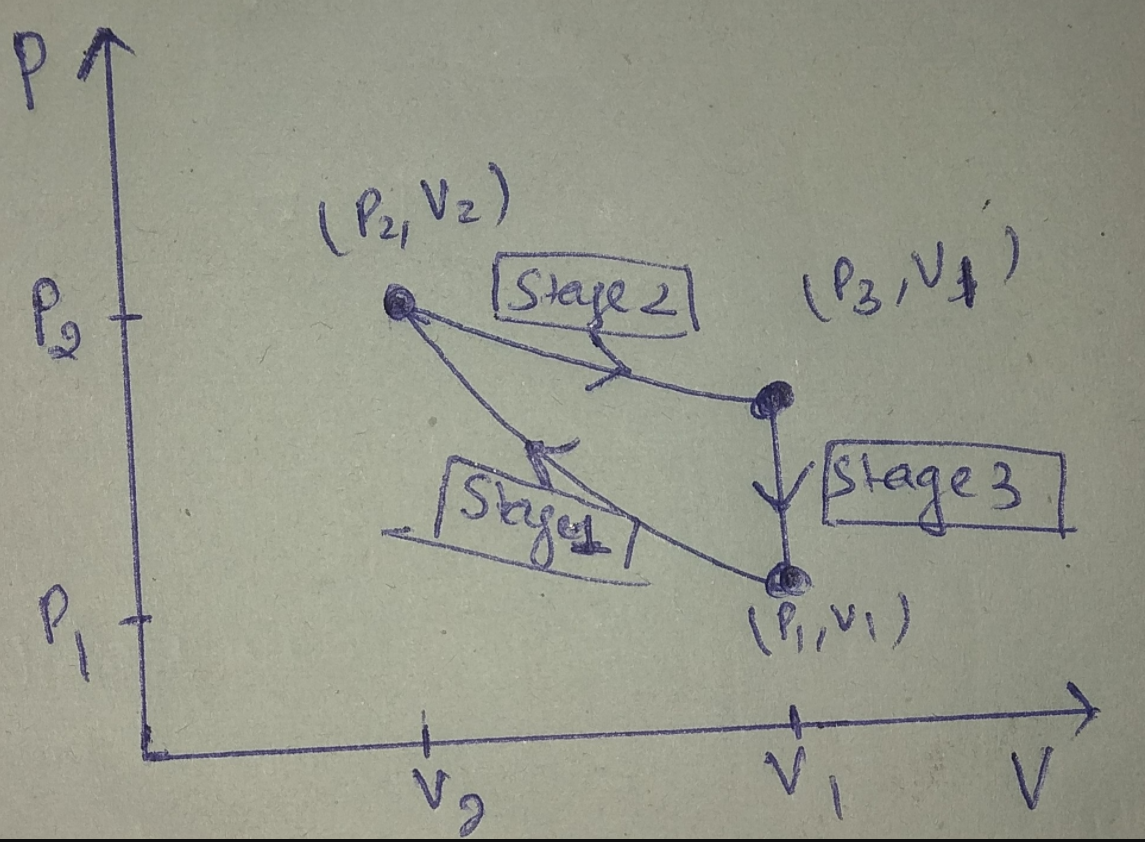a. Show the cycle as a pV diagram. Label the three stages. b. What is the energy transformation during each stage of the process? (For example, a stage in which work energy is transformed into heat energy could be represented as W→ Q.) Stage 1: Stage 2: Stage 3:
a. Show the cycle as a pV diagram. Label the three stages. b. What is the energy transformation during each stage of the process? (For example, a stage in which work energy is transformed into heat energy could be represented as W→ Q.) Stage 1: Stage 2: Stage 3:
College Physics
11th Edition
ISBN:9781305952300
Author:Raymond A. Serway, Chris Vuille
Publisher:Raymond A. Serway, Chris Vuille
Chapter1: Units, Trigonometry. And Vectors
Section: Chapter Questions
Problem 1CQ: Estimate the order of magnitude of the length, in meters, of each of the following; (a) a mouse, (b)...
Related questions
Question

Transcribed Image Text:10. The figure uses a series of pictures to illustrate a thermodynamic cycle.
Stage 3
Stage 1
Stage 2
Pin
Gas
The gas is compressed
rapidly from V, to V,.
The gas cools until the initial
pressure p, is restored.
The flame is turned off and
The gas is heated at constant
temperature until the volume
returns to V,
the piston is locked in place.
a. Show the cycle as a pV diagram. Label the three stages.
b. What is the energy transformation during each stage of the
process? (For example, a stage in which work energy is
transformed into heat energy could be represented as W→ Q.)
p
Stage 1:
Stage 2:
Stage 3:
P
Expert Solution
Step 1
STEP 1:
a)
The P-V diagram of the given process can be represented as,

b)
Stage 1:
The process is a fast process; thus, it is an adiabatic process.
From the first law,

Here, Q, U, W represent the heat, the internal energy, and the work-done, respectively.
For an adiabatic process, the heat energy remains the same.
Thus,

Thus, the work changes into internal energy,

Trending now
This is a popular solution!
Step by step
Solved in 2 steps with 10 images

Knowledge Booster
Learn more about
Need a deep-dive on the concept behind this application? Look no further. Learn more about this topic, physics and related others by exploring similar questions and additional content below.Recommended textbooks for you

College Physics
Physics
ISBN:
9781305952300
Author:
Raymond A. Serway, Chris Vuille
Publisher:
Cengage Learning

University Physics (14th Edition)
Physics
ISBN:
9780133969290
Author:
Hugh D. Young, Roger A. Freedman
Publisher:
PEARSON

Introduction To Quantum Mechanics
Physics
ISBN:
9781107189638
Author:
Griffiths, David J., Schroeter, Darrell F.
Publisher:
Cambridge University Press

College Physics
Physics
ISBN:
9781305952300
Author:
Raymond A. Serway, Chris Vuille
Publisher:
Cengage Learning

University Physics (14th Edition)
Physics
ISBN:
9780133969290
Author:
Hugh D. Young, Roger A. Freedman
Publisher:
PEARSON

Introduction To Quantum Mechanics
Physics
ISBN:
9781107189638
Author:
Griffiths, David J., Schroeter, Darrell F.
Publisher:
Cambridge University Press

Physics for Scientists and Engineers
Physics
ISBN:
9781337553278
Author:
Raymond A. Serway, John W. Jewett
Publisher:
Cengage Learning

Lecture- Tutorials for Introductory Astronomy
Physics
ISBN:
9780321820464
Author:
Edward E. Prather, Tim P. Slater, Jeff P. Adams, Gina Brissenden
Publisher:
Addison-Wesley

College Physics: A Strategic Approach (4th Editio…
Physics
ISBN:
9780134609034
Author:
Randall D. Knight (Professor Emeritus), Brian Jones, Stuart Field
Publisher:
PEARSON